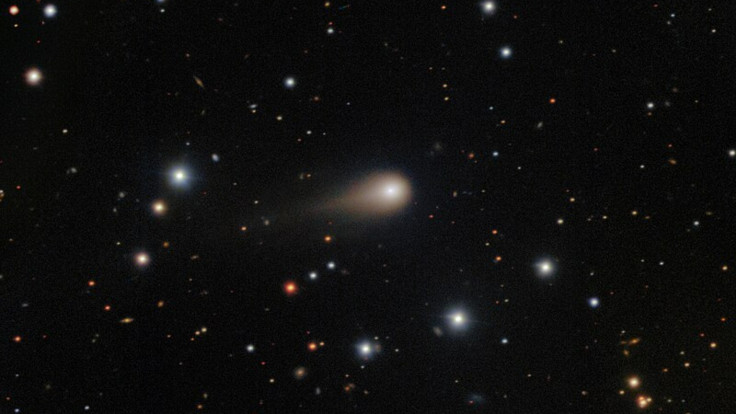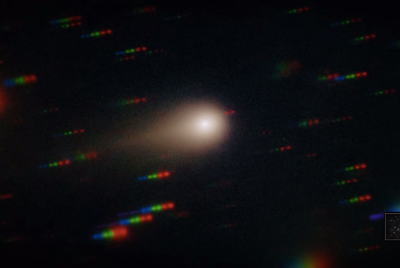Leaked Planetary Defense Papers Suggest U.S. Secretly Watched 3I/ATLAS for 20 Years
Classified images reveal structured emissions from 3I/ATLAS, hinting at two decades of covert U.S. planetary defence preparation.

Leaked documents and images suggest the United States has been quietly tracking interstellar comet 3I/ATLAS for more than 20 years, using an advanced planetary defence system never revealed to the public.
The documents, obtained by a Medium writer, reference a programme called CASSANDRA, first outlined in a 2005 academic paper, along with associated surveillance networks including ORACLE VI, ARGUS-VIS, and UMBRA-3/C. Observers and amateur astronomers have noted unusual geometric patterns and structured emissions from 3I/ATLAS inconsistent with natural cometary behaviour.
This prompts speculation that the object was a long-term test target for highly classified US space-based observation infrastructure.
CASSANDRA and ORACLE Programme
CASSANDRA was first presented at the 57th International Astronautical Congress in Valencia, Spain in 2005.
It was designed as a planetary defence strategy to monitor Near-Earth Objects (NEOs). The paper proposed an architecture capable of detecting threatening objects at extreme distances, tracking them continuously through cislunar space, and maintaining 'persistence custody' via distributed sensor networks.
While theoretical at the time, leaked images from November 2025 indicate that the system may have been operational much earlier than publicly acknowledged.
Then, the ORACLE programme was officially launched under the Air Force Research Laboratory (AFRL) in November 2022 through a $72 million (£59 million) contract to Advanced Space LLC. It operates at Earth-Moon Lagrange Point 1.
Publicly confirmed components include the ORACLE-M mobility demonstrator (2024) and ORACLE-P surveillance satellite (targeted 2026), equipped with a Leidos imaging payload capable of wide-field detection and narrow-field custody of objects.
Leaked visuals suggest these satellites were monitoring 3I/ATLAS during perihelion, capturing structured emissions inconsistent with natural comet activity.
ARGUS VIS and UMBRA for Surveillance and Tracking
The leaked images also mention ARGUS-VIS, a space-adapted derivative of DARPA's ARGUS-IS surveillance system. It reportedly operates 256 simultaneous video streams for persistent tracking across cislunar space.
Its designs mirror ORACLE's mission requirements, including wide-field detection and autonomous processing of massive sensor data.
Analysts suggest that ARGUS-VIS could have observed 3I/ATLAS in high resolution during perihelion, explaining the unusually precise documentation of its trajectory and geometric plasma emissions.
Then there's UMBRA's SAR satellite constellation, which provides complementary low Earth orbit surveillance. UMBRA's 32-satellite system, operational since 2021, captures 25-centimetre resolution synthetic aperture radar imagery capable of tracking moving targets in all weather and lighting conditions.
Combined with ORACLE, these assets appear to create a multi-layered surveillance network with continuous Earth-orbit and cislunar coverage.
CASSANDRA Database: Persistent Custody of Objects
At the core of the system is the CASSANDRA database, allegedly an exabyte-scale Apache Cassandra Infrastructure ingesting vast amounts of data from ORACLE and UMBRA sensors.
The database enables real-time object tracking, historical trajectory analysis, and automated threat assessment. Together, this maintains a 'persistent custody record' of objects passing through monitored space.
The November 2025 Images of 3I/ATLAS
On 2 November 2025, four days after 3I/ATLAS reached perihelion, two images appeared online labeled 'C/2025 N1 UMBRA-3/C' and 'CASSANDRA / ORACLE VI ARGUS-VIS'.

One showed a geometric, star-shaped emission core in black-and-white resolution. The other displayed a green coma with white-pink plasma streams in colour.

Analysts note that the emissions' structured, multi-directional nature strongly contrasts with natural cometary outgassing, suggesting artificial control of observation.
3I/ATLAS and America's Two Decades of Preparation
The conclusion is that the leaked evidence, theorised in 2005, may have been operational in 2025 with 3I/ATLAS serving as a deliberate test subject. This also raises questions on how far the coordination between military and space entities has progressed to build a modern planetary defence with national security operations.
Regardless, with NASA's pending release of its photos of the comet, the public may never fully understand the scope of CASSANDRA and its related systems until more documentation is declassified.
© Copyright IBTimes 2025. All rights reserved.




















